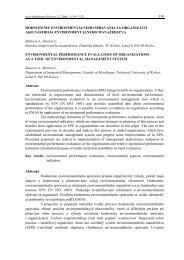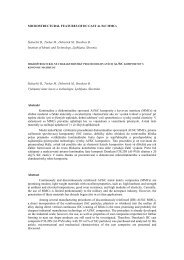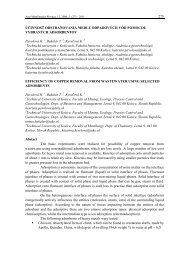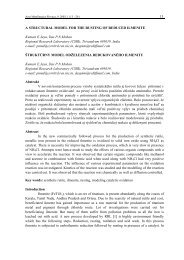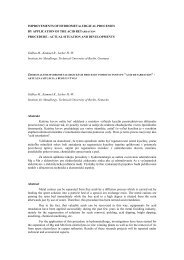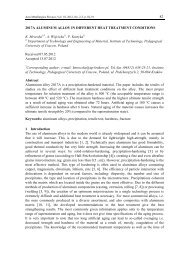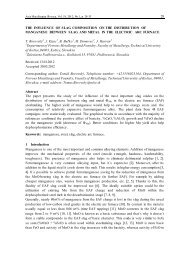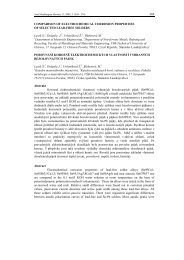You also want an ePaper? Increase the reach of your titles
YUMPU automatically turns print PDFs into web optimized ePapers that Google loves.
Acta Metallurgica Slovaca, 10, 2004, 4 (327 - 338) 332t.ln dwt/d1,811,81,791,781,7764 66 68 70 72 741/T, K x10 4Fig.5 The Arrhenius plot of copper sulfide-lead reaction.Pb in copper, weight percent109,598,587,576,561100 1150 1200 1250 1300Temperature, °C.10% CuS 20% CuSFig.6 Effect of temperature on lead content in copper using 10% and 20% by weight copper sulfide as decopperingagent.3. 2.3 Melting with additives and blowing of oxygen gas to remove tin and lead from the moltencopper scrapFigure 6 shows the effect of adding 10% and 20wt % copper sulfide on lead contentin the obtained copper alloy by melting at temperatures up to 1300°C for 15 minutes. It can beseen that lead content decreased by increasing both the temperature and amount of coppersulfide added. Oxidation of these metals in the scrap may proceed in a multi steps sequence.However, direct oxidation of these metals with oxygen gas would not take place on basis of ∆G ovalue of the M-O 2 reactions. Oxidation of tin, lead and copper metals in the scrap depends on the∆H values given in Table 1.Table 1 The activation energy value obtained for the oxidation processes.∆H value, kJ/molFlow rate of oxygen, L/min with LeadFlow rate of oxygen, L/min with Tin0 0.2 0.4 0.6 0 0.2 0.4 0.665.6 79.12 72.85 69. 36 119.22 145.29 114.1 95.4Sn 2+ + 2e - ↔ S n - 0 .136 v (1)Pb 2+ + 2e - ↔ Pb - 0.126 v (2)Cu 2+ + 2e - ↔ Cu + 0.3402 v (3)Therefore, oxidation reaction takes place more readily with the metal having a morenegative potential such as tin. The sequence of oxidation of these metals would be in the orderSn (-0.1364v), Pb (-0.126v) and copper (+0.3402v) that is nobler than Sn. However, oxygen
Acta Metallurgica Slovaca, 10, 2004, 4 (327 - 338) 333bl owing at low pressure was insufficient to remove completely lead and tin from copper. Thisfinding suggests that the extent of removal would be related to the equilibrium: M ↔ MO,which shifts to the right direction only at high oxygen partial pressure. Table 2 shows somephysical properties of lead, tin and copper metals and their oxides. The formed oxides went toslag because they are thermo-chemical stable andTable 2 Some physical properties of lead, tin and copper metals and their oxidesPropertyChemical Specific gravity, g/cm 3 Melting point, °CMaterial formula Metal Oxide Apparent Metal OxideCopperCopper oxideLeadLead oxideTinTin oxideTin oxideCuCuOPbPbO (yel.)SnSnOSnO28.9211.347.286.380.440.955.946.30.410.881083327231132688610801630have low-density v alues compared t o free metals. Frequent skimming of the floating slagmanaged metals oxides re-entry into the molten copper at minimum.Calculation of the free energy change, ∆G o for copper oxidation :∆G o = – 79.42 – 120.8T kJ/mol (4)The equilibrium constant K for this reaction is;K (Cu2S (l) ) =α (Cu2S(l)) /(α Cu ) 2 x(α S ) (5)Golonka determined the activity of copper in copper-silver alloys and the activity coefficientdata were fitted to the Kuprowski’s formalism by Wladyslaw:1.9For copper: Logϒ Cu = 700 [(1-X Cu ) ] / T (6)For lead:Logϒ Pb = 700 [(1X Pb ) 1.9 ] / T (7)Experimentally the weight % of Pb and Sn in the molten copper is relatively small, then:( wt%Pb)( 63)( 207)( 100)X Pb = (8)The equation of equilibriUm of Pb content in copper::Wt%Pb =and for Sn it becomes :Wt%Sn =( α ) 1Pb 2+() l( 207)( 100)2o( γ )( α ) 1 4K 1 ( 63)PbS( α ) 1Pb 2+() l( 118.69)( 100)2o1γ ( )4K 1 63( ) ( )Pb α S44(9)(10)Figure 7 shows the effect of heating time and using different stoichiometric ratio ofcopper sulfide with subsequent blowing of oxygen gas on lead and tin content in the produced
Acta Metallurgica Slovaca, 10, 2004, 4 (327 - 338) 334copper alloy respectively. Experiments took place at 1300°C for periods up to 40 minutes. Thecontent of tin and lead in the obtained copper alloy(s) decreased by increasing both the amountof copper sulfide added and time. This behavior can be summarized as follows:opper, weightercent.Pb in cp1098765432105 10 15 20 25 30 35 401086420Sn in co pper, weigh tpercent.Time, minute.1 st. ratio 1.25 st. ratio1.5 st. ratio 1 st. ratio1.25 st.ratio 1.5 st. ratioFig.7 Effect of heating time with blowing oxygen gas (10 L/min) on lead and tin (---) in obtained copper using 1, 1.25and 1.5 stoichiometric ratio of copper sulfideCopper sulfide decomposes to copper and sulfur:Cu 2 S (l) 2Cu (l) + S (l) (nascent) (11)Sulfur then reacted with tin and lead to form the respective sulfides.S (l) + Pb (l)PbS (s)(12)S (l) + Sn SnS (l)(13)SnS (l) Sn (l) + S (l) (14)The thermo-chemical stability of the formed sulfides follows the order PbS >SnS >Cu 2 S.Atmospheric oxygen gas then oxidi zes tin or lead to form their oxide that goes to slag.In presence of Cu 2 S in the molten sc rap alloy, oxygen blowing enhanced the following oxidationreactions and helped removal of tin and lead from the molten copper.SnS (l) + ½O 2 (g) SnO ( + S (15)2Cu (l) + ½ O 2 Cu 2 O (s) (16)Copper oxide decomposed at 1050°C to cuppric oxide:Cu 2 O (s)CuO (s) +Cu (l)(17)Tin metal may reduce CuO according to:CuO + Sn Cu+SnO (18)
Acta Metallurgica Slovaca, 10, 2004, 4 (327 - 338) 335Therefore, increasing the stoichiometric ratio of Cu 2 S reagent stimulated the removalof lead and tin in agreement with the law of mass action. Under stirring conditions, nearly all thealloying light metals oxidized and went to the slag. From the before said data, it can beconclude d that copper sulfide followed by oxygen blowing has been found to be most suitable toremove lead and tin from molten copper. The optimum conditions to manifest adequate removalof tin and lead is to melt the scrap at 1250°C for 15 minutes using 1.25 stoichiometric ratio ofcopper sulfide reagent with subsequent blowing of oxygen gas at a rate of 10 L/min.tion, weight.Extent of extracpercen504030201000 2 4 6 8 10 12Concentration of 1:1 HCl/HNO 3 ,MFig.8 Effect of molarity of 1:1 HCl/HNO 3 mixture on the extent of leaching tin, copper and lead from the slag.SnCuPb3.3 Acid/Alkali leaching of the formed slag after removal of lead and tinFigure 8 shows the effect of change in molarity of 1:1 HCl/HNO 3 mixture on theext ent of leaching tin, copper and lead from the slag. Leached lead compounds dissolved inaqueous ammonium acetate solution whereas tin oxide did not. After filtration, lead acetate wastreated with sodium carbonate solution according to:Pb(C 2 H 5 O 2 ) 2 + Na 2 CO 3 PbCO 3 + 2 Na(C 2 H 5 O 2 ) (19)The carbonation process was carried out at room temperature for 3 h with a recoverypercentage of 99.8%. Heating lead carbonate produced lead oxide whereas lead acetatedecomposed to ammonia, acetic acid and lead oxide.Hot HCl / HNO 3 acid mixture disso lved almost these metals to form soluble copperand lead chlorides whereas SnCl 2 deposits. Heating of the solution and filtration while hot helpsseparation of undissolved SnCl 2 . Lead chloride on the other hand dissolved and can be filtered.It was precipitated upon cooling to room temperature and separated by filtration. Ammonia isselective for copper to form copper tetra-ammonium complex that dissolved in water (Fig.9).Similar reactions may take place in case of tin or lead failed. The reactions with ammonia wereas follows:4 NH 4 OH 4 (NH 4 ) + + 4 OH - (20)M + 2 OH - MO + H 2 O + 2e - (21)MO + 4 (NH 4 ) + + 2e - M(NH 3 ) 4 .(OH) 2 + 2H + (22)+2H + 2OH - 2H2O (23)and the overall reaction gives metal-tetrammonia M(NH ) 4 .(OH) nd water :3 2 a
Acta Metallurgica Slovaca, 10, 2004, 4 (327 - 338) 337and nascent oxygen. Liberation of nascent oxygen explains the effect of peroxide enhancing theoxidation of tin and lead metals before the acid or alkali attack. It can be concluded thatd issolution of the formed slag in acid solution dissolves almost all the metals in the slag.Ammonia is the only selective agent to dissolve copper. Ammonium acetate leached leadcarbonate. Hydrogen gas reduced lead carbonate and stannous oxide at 900°C and 600°C toproduce lead and tin metals respectively. The purity of copper, lead and tin was found to be99.18, 99.8 and 98.67 respectively and the corresponding recovery figures were 96.2, 94.6 and95.7 %.Conclusions1) Metallic copper was recovered from bronze scrap containing 80-83 % copper, 9-10%lead and 8-9 % tin by pyrometallurgical treatments like melting of scrap with removalof the slag.2) Addtion of additives, CuS coupled with oxygen blowing during melting of the scrap at1250°C for 15 minutes has been found best experimental condition to remove lead andtin from the bronze scrap.3) Hot acid leaching dissolves almost all metals present in the slag. Ammonia wasselective to leach copper only.4) Addition of hydrogen peroxide to the leaching solutions enhanced dissolution of themetals of concern.Literature[1] Abdul Basir S., Rabah M.A.:(2001) ““Recycling of pure copper, lead and tin from bronzeturnings” 40th Annual Conf. Of Metallurgists of CIM, Proc. 4 th Int. Symp. On wasteprocessing and recycling in mineral and metallurgical industries IV , S.R. Rao; P.D.Kondos; N. Kuyucak; L.M. Amaratunga; G.G. Richards and J.A. Kozinski (Editors), Aug.26-29 2001, 79-91.[2] Allain E., Gaballah I.: (1994), “Recycling of strategic metals from industrial slag by hydroand pyrometallurgical processes”, Recycling of Materials in Industry Conf., Strasbourg,France, 3-6 Nov. 1992, Resource Conserv. Recycl. 10, pp1-2.[3] Banerji A., Liu L., Reif W., Sommer F., Zhen B.L.:(1994), “ Effect of homogenizationtemperature on the cast structure of IN738 superalloy”, Metall. Mater. 30 (5), pp 593-98.[4] Baranowski R., Gorka P., Kowalski S.:(1993), Zesz. Nauk Politech. Slask. Chem., 127,109-117.[5] Betterton B.C., Picard D.G., Queneau P.B.:(1995), “Recycling copper in North America”,Short Courses, 34th Annual Conf. of Meatllurgists, CIM, Vancouver Canada, August.[6] Bukhard R., Hoffeiner G., Eschenbach R.C.: (1994), “ Recycling of metals from waste withthermal plasma”, Resource, Conserv. Recycl., 10, (1-2), pp 11-16.[7] Gaballah I., Ferreira S., Djona M.: (1995), “Recovery of metals contained in spent catalysts215-using a thermal treatment followed by selective chlorination”, Rev. Metall. 31(4) pp221.Golonka J.: (1965), Arch. Hutnicwa, vol. 10(2), pp 143-165.[8][9] Gorushkina L.P.: Ostroverkhov, V.Yu. and Gaevoi, A.E., (1993), “ Investigation intocopper melting process for shaped castings” Liteinoe Prozivod 11, pp 14-15.
Acta Metallurgica Slovaca, 10, 2004, 4 (327 - 338) 338[10] Ludovicus M. D., Denis L. F.: Woluwe St.Pierre and K.G., Beerse, (1972), “Copperrefining process”, U.S Patent 3 682623, Aug.8, Ser. No. 80,585 Cl. C22b 15/14[11] Maker H.V., Riley W.D.: (1985), “Metallurgical effects of impurities in recycled copperalloys”, U.S dept. Interior, Bereau of Mines, Washington DC, 20241, Inf. Circ. No. 9033[12] Nelmes W.S.: (1984), “The Secondary copper blast-furnace”, Conf. Institution of Miningand Metallurgy, New College, University of Oxford April, 2-3 32-38.[13] Weast R.C., Astle M.J.: (Editors) (1979-1980), “CRC Handbook of Chemistry andPhysics” 60th Edition, Values of chemical thermodynamic properties D-67 -D-77, CRCPress Inc. Boca Raton, Florida USA[14] Yedavalli B.V.S., Saha A.K.: (1994) “Recovery of copper and zinc from scrap leadedbrass” NML Tech. J. Jan-Mar (1994), 36 (1) pp1-9.



